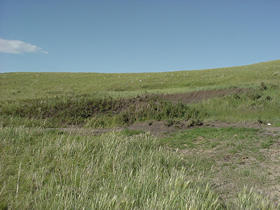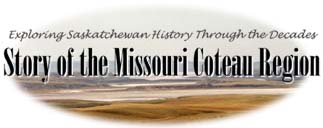 After
the turn of the century, settlers began arriving in this area
to start the serious business of farming in this great new land.
Imagine their delight to find seams of coal on the surface of
the ground and gopher mounds of pure coal on the hillsides. Such
was the case on section 22-4-16 about four miles west of Maxim.
This land, some now owned by Pat Doud and the rest owned by Sidney
Lindskog, was soon the scene of much activity in the coal business.
The first miners here were the Kaisers who homesteaded a quarter
there. Bill Dee applied for coal mining lease on the north half
of legal subdivision in 22-4-1 on April 20, l9l0. In l910 W. J.
Ewing had a mining lease on the east half of legal subdivision
8 in 22-4-16. From 1923-l925 Joseph Doud had a lease on Sl/2 of
L S 4 in 22-4-16. From 1925 to 1930 Andrew Luplac had a lease.
Edward Schad, Fred Markowski, Mackay and Wright, Frederick and
Insko were also known to mine there.
After
the turn of the century, settlers began arriving in this area
to start the serious business of farming in this great new land.
Imagine their delight to find seams of coal on the surface of
the ground and gopher mounds of pure coal on the hillsides. Such
was the case on section 22-4-16 about four miles west of Maxim.
This land, some now owned by Pat Doud and the rest owned by Sidney
Lindskog, was soon the scene of much activity in the coal business.
The first miners here were the Kaisers who homesteaded a quarter
there. Bill Dee applied for coal mining lease on the north half
of legal subdivision in 22-4-1 on April 20, l9l0. In l910 W. J.
Ewing had a mining lease on the east half of legal subdivision
8 in 22-4-16. From 1923-l925 Joseph Doud had a lease on Sl/2 of
L S 4 in 22-4-16. From 1925 to 1930 Andrew Luplac had a lease.
Edward Schad, Fred Markowski, Mackay and Wright, Frederick and
Insko were also known to mine there.
 The
last commercial miners on this section were Fred Markowski and
Eddy Ror on the east side of the coulee and Bill Frederick and
Shorty Insko on the west side. They quit in 1936. The last one
to mine was John Raknerud. He dug a strip with a spade about a
foot deep right in the coulee bottom just for his own use.
The
last commercial miners on this section were Fred Markowski and
Eddy Ror on the east side of the coulee and Bill Frederick and
Shorty Insko on the west side. They quit in 1936. The last one
to mine was John Raknerud. He dug a strip with a spade about a
foot deep right in the coulee bottom just for his own use.
 These
mine operators had many hired men over the years. To mention them
all would be a hopeless task. Some of them still living around
here are Eddy Ror, Mike Doud, William Frederick, Wally Hall, and
Charlie Frederick.
These
mine operators had many hired men over the years. To mention them
all would be a hopeless task. Some of them still living around
here are Eddy Ror, Mike Doud, William Frederick, Wally Hall, and
Charlie Frederick.
 Inspectors representing the department of the Interior, Mining
Lands and Yukon Branch visited the mine regularly. They had offices
in Estevan and Moose Jaw. Their reports listed the type of coal
as lignite. The coal seams in these reports varied from six to
seven feet with quantity of slack from 25 to 40%. There were also
bands of dirt. In one report a band 3" and another 6".
Inspectors representing the department of the Interior, Mining
Lands and Yukon Branch visited the mine regularly. They had offices
in Estevan and Moose Jaw. Their reports listed the type of coal
as lignite. The coal seams in these reports varied from six to
seven feet with quantity of slack from 25 to 40%. There were also
bands of dirt. In one report a band 3" and another 6".
 Coal was disposed of in local trade. Price was $2.50 per ton.
The lease cost $20.00 a year. There was often trouble paying this
amount.
Coal was disposed of in local trade. Price was $2.50 per ton.
The lease cost $20.00 a year. There was often trouble paying this
amount.
 Inspectors were never pleased with safety precautions. They always
requested that more timbers be put up. They also found the mine
going in directions not applied for in the lease; sometimes they
had to issue a lease for a different subdivision. Miners were
requested to fill in old mine holes. Tunnels extended as far as
700 feet. Some tunnels went 150 feet before reaching good coal.
A royalty of 5¢ a ton was paid.
Inspectors were never pleased with safety precautions. They always
requested that more timbers be put up. They also found the mine
going in directions not applied for in the lease; sometimes they
had to issue a lease for a different subdivision. Miners were
requested to fill in old mine holes. Tunnels extended as far as
700 feet. Some tunnels went 150 feet before reaching good coal.
A royalty of 5¢ a ton was paid.
 Coal was dug by hand and hauled out on a horse drawn stone boat.
The horse would often sense a cave in and step ahead so the dirt
would fall on the stone boat.
Coal was dug by hand and hauled out on a horse drawn stone boat.
The horse would often sense a cave in and step ahead so the dirt
would fall on the stone boat.
 One of the mine operators had big ideas on mining. He brought
in narrow gauge rails and coal cars, etc., but it didn't seem
to work out anyhow. Most of the coal was hauled out with a horse
and kind of a stone boat affair. This outfit was about eight feet
long by two feet wide by two feet high with two wheels towards
the back end. It held about one half ton of coal. Four loads would
fill an ordinary sleigh box.
One of the mine operators had big ideas on mining. He brought
in narrow gauge rails and coal cars, etc., but it didn't seem
to work out anyhow. Most of the coal was hauled out with a horse
and kind of a stone boat affair. This outfit was about eight feet
long by two feet wide by two feet high with two wheels towards
the back end. It held about one half ton of coal. Four loads would
fill an ordinary sleigh box.
 The
big risks in mining were the cave-ins. As far as is known there
was only one man who lost his life in these mines. He was Mr.
Wilson who had a homestead to the east and south of Radville,
just west of the Laurier gravel pit. He is buried along the road
allowance on his homestead there. Some were hurt. George Baycroft
got caught in a cave-in and walked bent over for many months.
Bill Dee was also injured in a cave-in; his hip was injured for
life.
The
big risks in mining were the cave-ins. As far as is known there
was only one man who lost his life in these mines. He was Mr.
Wilson who had a homestead to the east and south of Radville,
just west of the Laurier gravel pit. He is buried along the road
allowance on his homestead there. Some were hurt. George Baycroft
got caught in a cave-in and walked bent over for many months.
Bill Dee was also injured in a cave-in; his hip was injured for
life.
 Mike Doud and Jim Doud found a dinosaur bone in Schad's mine in
the 30's. They put it on the ground and in two days it had disintegrated
to powder. The bone was probably two feet long, nine or ten inches
across at the ends, shaped like a chicken bone.
Mike Doud and Jim Doud found a dinosaur bone in Schad's mine in
the 30's. They put it on the ground and in two days it had disintegrated
to powder. The bone was probably two feet long, nine or ten inches
across at the ends, shaped like a chicken bone.
 It
was too big for a buffalo.
It
was too big for a buffalo. They were digging an entry into a new mine. Before the railways
came through and small towns appeared on the scene, people came
to the mines from as far away as twenty-five miles. This would
be a long, cold, two-day trip for some. It's a wonder many of
them didn't freeze to death. Coal was only mined in the winter
because it would turn to slack in a short time.
They were digging an entry into a new mine. Before the railways
came through and small towns appeared on the scene, people came
to the mines from as far away as twenty-five miles. This would
be a long, cold, two-day trip for some. It's a wonder many of
them didn't freeze to death. Coal was only mined in the winter
because it would turn to slack in a short time.
 An interesting sideline to mining for some was the making of home-brew.
This went on for years at the mines. Not all did this but some
of them certainly were. Surely there are still many gallons of
brew hidden back in the mine holes.
An interesting sideline to mining for some was the making of home-brew.
This went on for years at the mines. Not all did this but some
of them certainly were. Surely there are still many gallons of
brew hidden back in the mine holes.
 After the early l940's the mines were not operated any more but
they still claim people's attention at times. It was only a few
years ago that Gordon Raknerud had his tractor drop into a hole.
Also Sidney Lindskog had a mine cave under his tractor. These
farmers can trace some tunnels by the depression on the land.
The mines are done but certainly they are not forgotten.
After the early l940's the mines were not operated any more but
they still claim people's attention at times. It was only a few
years ago that Gordon Raknerud had his tractor drop into a hole.
Also Sidney Lindskog had a mine cave under his tractor. These
farmers can trace some tunnels by the depression on the land.
The mines are done but certainly they are not forgotten.

